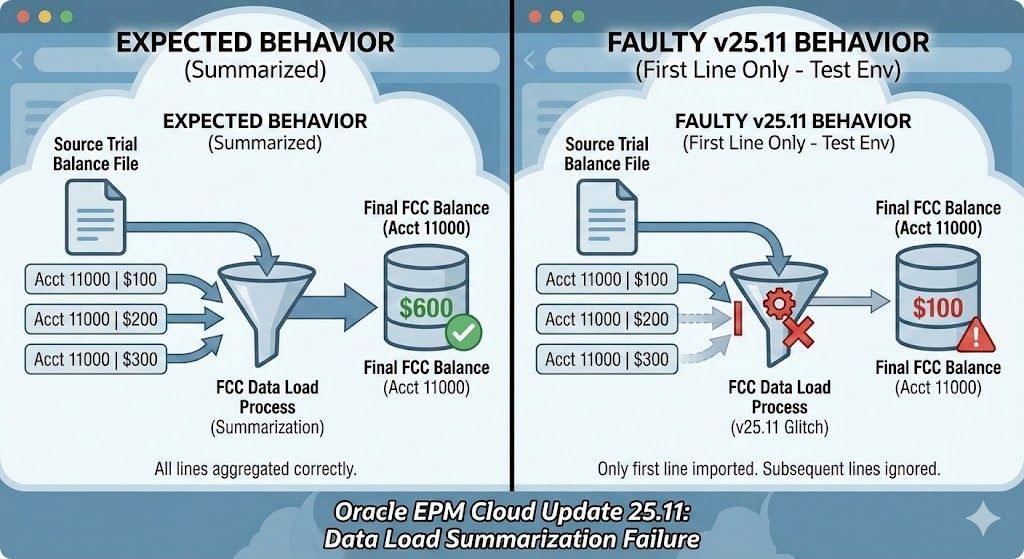Mastering Consolidations in Oracle FCCS: From Ownership to Equity Pickup
Nadia Lodroman • 9 June 2025
Listen to Tresora and Ledgeron's chatting about this blog post:
A Deep Dive into Oracle FCCS Consolidation and the Nuances of the Equity Method
For any organization with a multi-entity structure, the financial close is a recurring, high-stakes endeavor. Aggregating data from various subsidiaries—each with its own set of books—into a single, accurate, and compliant consolidated financial statement is a complex puzzle. Oracle Financial Consolidation and Close (FCC) is a purpose-built cloud solution designed to solve this puzzle, bringing automation, transparency, and control to the entire process.
This guide will walk you through the core mechanics of how Oracle FCC consolidates child entities, focusing on the critical roles of ownership, consolidation methods, and the data-auditing trail. We'll also take a deep dive into a frequently misunderstood concept: the difference between the Equity Method of accounting and the Equity Pickup calculation.
The Cornerstone of Consolidation: Ownership and Consolidation Methods
The entire consolidation process in FCCS is anchored by Ownership Management. Here, you define the group's legal structure, specifying the percentage of each child entity owned by a parent. This ownership percentage is the primary trigger that determines the Consolidation Method applied to that subsidiary's data.
FCCS comes pre-configured with standard accounting methods:
- Subsidiary: Used when ownership confers control, typically over 50%. In this case, 100% of the subsidiary's assets, liabilities, and P&L are combined with the parent's. The portion not owned by the parent is calculated and backed out as Non-Controlling Interest (NCI).
- Proportional: Often applied to joint ventures where control is shared. The parent company includes its proportionate share of each of the subsidiary's financial line items. For example, with a 40% ownership stake, 40% of the subsidiary's assets, liabilities, and P&L are brought into the consolidation.
- Equity: Applied when the investor has significant influence but not control, typically with ownership between 20% and 50%. This method is treated differently from the others, as we will explore in detail later.
- Not Consolidated: For minor investments (usually under 20%), where the investment is typically held at its initial cost.
The Data Flow: Tracing the Consolidation Path
To ensure a clear and auditable trail, Oracle FCCS processes data through specific members of the Consolidation Dimension. This allows users to see exactly how a subsidiary's standalone data transforms into its final consolidated contribution.
- Entity Input: This is the raw, standalone trial balance data for the child entity, either loaded from a source system or entered directly.
- Proportion: The system applies the relevant ownership percentage to the Entity Input data. For a Subsidiary, this will be 100%. For Proportional, it will be the ownership percentage (e.g., 40%). The result is stored in the Proportion member.
- Elimination: This crucial step prevents the overstatement of financials by removing intercompany transactions and balances. FCCS automatically identifies balances between a parent and child (or between two sister subsidiaries) and posts eliminating entries at the first common parent in the hierarchy. This ensures that, for example, an intercompany loan and its corresponding note payable net to zero in the consolidated view. These adjustments are stored in the Elimination member.
- Contribution: This is the final, netted result. It represents the sum of the Proportion and Elimination members. The total Contribution from all children, added to the parent's own data (Entity Consolidation), produces the final consolidated numbers for the group.
A Deeper Dive: Equity Method vs. Equity Pickup
This is where some of the most powerful automation within FCCS comes into play, but it's also a source of confusion. What is the difference between the Equity Method and Equity Pickup?
The key takeaway is this: They are not two different options. The "Equity Pickup" is the specific set of calculations that executes the "Equity Method" of accounting.
- The Equity Method: This is the accounting principle. It dictates that when you have significant influence (e.g., 30% ownership), you don't consolidate the investee's assets and liabilities line-by-line. Instead, you recognize your initial investment on your balance sheet as a single line item ("Investment in Associate"). Then, periodically, you adjust the value of that investment and recognize your share of the associate's profit or loss on your income statement.
- Equity Pickup (EPU): This is the process within FCCS for performing that periodic adjustment. When you enable the Equity Pickup feature in FCCS, it deploys dedicated rules and dimension members (EPU in the Data Source dimension) to automate this calculation.
How Equity Pickup Works in FCCS
The EPU process is distinct from a standard consolidation and follows a specific sequence to ensure accuracy, especially in complex, multi-layered ownership structures.
- Trigger: The process is triggered for entities consolidated using the Equity Method.
- Calculation: The core EPU rule calculates the change in the subsidiary's total equity for the period (essentially, its net income less any dividends paid).
- Adjustment: The rule then "picks up" the parent's ownership share of that change. It posts this amount to two key places on the parent company's books:
- It debits (increases) the "Investment in Associate" account on the Balance Sheet.
- It credits (increases) the "Income from Equity Companies" account on the Income Statement.
The result is that the investment's carrying value on the parent's balance sheet is adjusted from its historical cost to reflect the current value of the equity owned, and the parent's net income accurately reflects its share of the associate's performance. FCCS handles this complex sequence automatically, running the calculations generation-by-generation from the bottom of the entity structure upwards to ensure that the income from a lower-tier subsidiary is correctly reflected in the investment value of a mid-tier holding company before that holding company's own EPU is calculated.
Tying It All Together
Understanding the logic of how Oracle FCCS handles different ownership structures is fundamental to ensuring a smooth, accurate, and compliant financial close. By grasping the flow through Proportion, Elimination, and Contribution, and by understanding the nuances between a broad accounting method and a specific operational pickup, you can move from simply using the software to truly mastering it. This clarity not only builds confidence in your consolidated numbers but also empowers your finance team to provide deeper insights into the performance of the entire corporate group.
By automating these distinct consolidation methods and providing a transparent data trail, Oracle FCCS allows finance teams to manage complexity with confidence, reduce close cycles, and focus on what truly matters: delivering accurate financial insights that drive the business forward.






